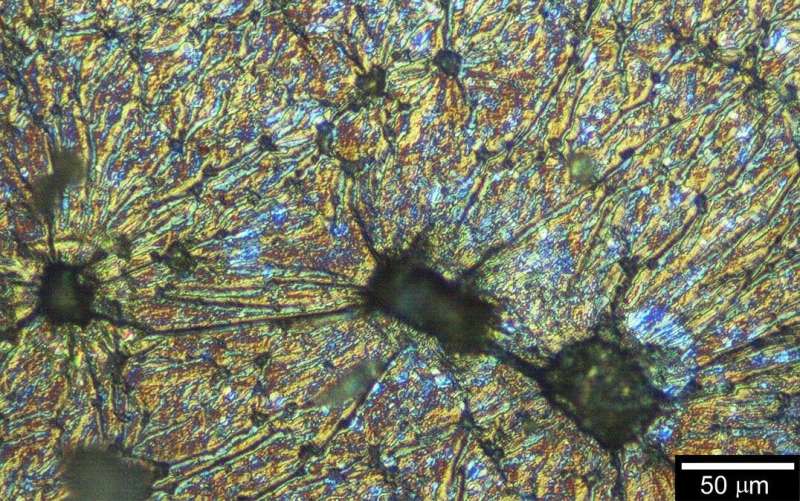Researchers from the University of Tsukuba have assembled non-harmful virus particles to form "handed" templates for growing polymers with magnetic properties. Credit: University of Tsukuba
Certain molecules have features that cause them to group together in particular ways, known as self-assembly. The formed structures can then be used as templates for growing polymers in ways that would otherwise be difficult to achieve. Researchers from the University of Tsukuba have already shown that helical liquid crystals can be used to grow conducting polymers. Now, they have extended their method to include fd phage liquid crystal platforms. Their findings are published in Journal of Polymer Science.
Virus particles that are non-harmful provide excellent ready-made building materials. For example, they can be used as scaffolds or containers for cargo. Fd phages—whose function is to infect bacteria—are linear viruses that look like cooked spaghetti.
However, they can also act as liquid crystals and organize themselves into helical structures. Helices are interesting because they have a property known as "handedness"—they turn either clockwise or anticlockwise. Using helical structures as a platform for growing polymers is an excellent way of introducing a helical arrangement into the final polymer material. Although this has been done using standard liquid crystals, this is the first report of using viruses as helical templates for polymerization.
The researchers grew polypyrrole—a conducting polymer—on the fd phage template using a double-step chemical-electrochemical polymerization process and they examined the structure and magnetic properties of the product.
"The polypyrrole formed a network of small branch-like fibers, similar to the neural network in the brain," explains study main author Professor Hiromasa Goto. "We found that the polymer networks had helical antiferromagnetic behavior, which we believe is because the polymer formed a helical structure at the molecular level as a result of adopting the organization of the virus liquid crystal."
In polypyrrole, the charge is carried by "polarons," which are pairs of radicals and cations. Because the polarons in the main chain of the polymer take on the helical structure dictated by the virus template, their interaction leads to antiferromagnetic-like behavior.
The combination of virus particles and conducting polymers has led to reports of numerous very interesting systems including virus/polymer nanowires for biosensors, conducting polymer-based COVID-19 detectors, and chemically modified viruses. There are therefore numerous potential applications for systems based on helical conjugates.
"Combing the useful properties of fd phages—such as their ability to recognize and infect specific bacteria—with conducting polymers that have magnetic properties opens many doors," says Professor Goto. "For example, our composite could be used for specific virus detection and selective virus capture and extermination."
More information: Hiromasa Goto et al, A possibility of polaron vortex magnet of polypyrrole prepared in virus liquid crystal, Journal of Polymer Science (2021). DOI: 10.1002/pol.20210585
Provided by University of Tsukuba
























